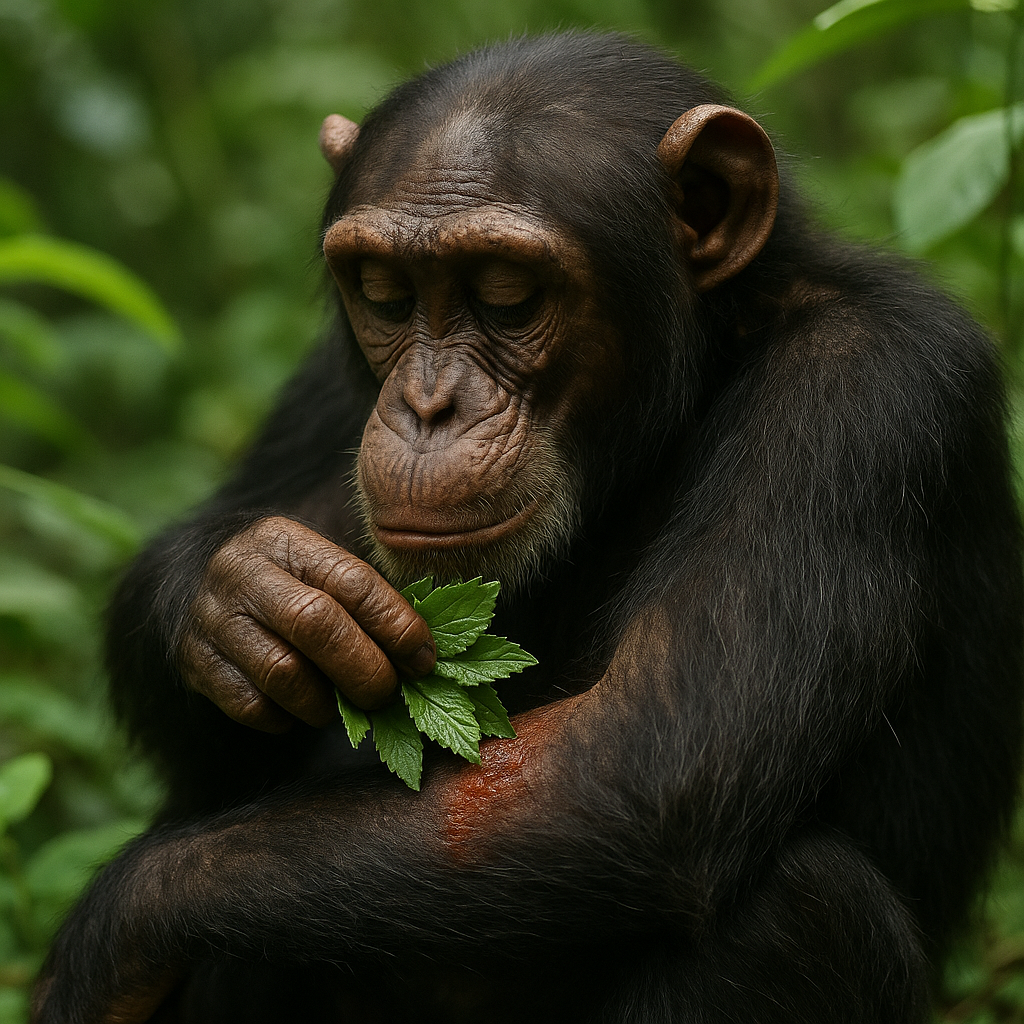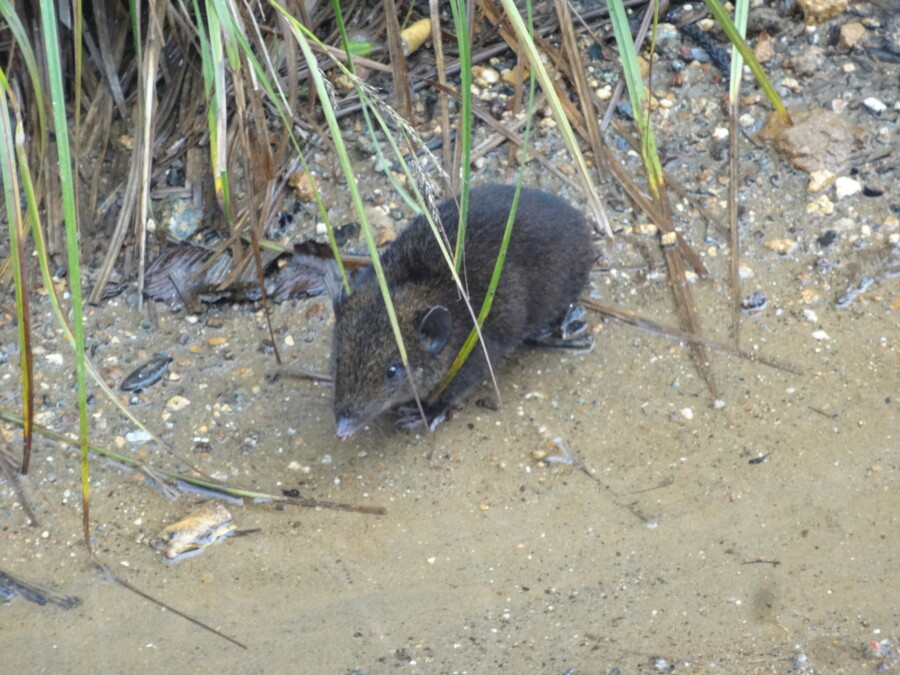Recent studies in Uganda have shown that wild chimpanzees are using plants to help heal their injuries. Researchers from the University of Oxford, along with a local team in Budongo Forest, observed these chimpanzees using plants as a kind of first aid. This research builds on earlier findings that chimpanzees look for specific plants to treat themselves. By gathering years of observations, scientists have created a detailed list of how chimpanzees practice what can be called “forest first aid.”
The study was published in a journal called *Frontiers in Ecology and Evolution*, and it adds to the growing evidence that primates like chimpanzees, orangutans, and gorillas use natural remedies to stay healthy in the wild. Elodie Freymann, the lead researcher, pointed out that chimpanzees show different behaviors when they are sick or hurt, including treating their own injuries and keeping clean. For example, some chimpanzees have been seen putting plants on their wounds or chewing them up before applying the paste to their injuries.
One interesting observation involved a young female chimpanzee who was seen chewing on a plant and then putting it on a wound on her mother. The researchers also noticed that chimpanzees sometimes help each other with injuries, which suggests they might feel empathy. These findings are important because they show that chimpanzees have complex social and emotional behaviors.
The research team also used a lot of notes collected over many years at a field station in Budongo Forest. This logbook includes detailed stories from local staff, researchers, and visitors about what they have seen chimpanzees do. Some notes describe chimpanzees using leaves to treat injuries or helping others get rid of traps. One note even mentions a chimpanzee using leaves for cleaning itself after going to the bathroom, showing behaviors that are similar to humans. The researchers also found that many of the plants chimpanzees use have antibacterial properties, which could lead to new medicines. Dr. Freymann highlighted that studying these wild chimpanzees gives us valuable insights into nature and how these animals survive in their environment.
Original news source: Wild chimpanzees filmed using forest ‘first aid’ (BBC)
🎧 Listen:
Slow
Normal
Fast
📖 Vocabulary:
| 1 | chimpanzees | A type of large ape that lives in Africa and is closely related to humans |
| 2 | observations | Things you notice or see when watching something carefully |
| 3 | remedies | Treatments or cures for illnesses or injuries |
| 4 | empathy | The ability to understand and share the feelings of another |
| 5 | logbook | A book where you write down notes and records |
| 6 | antibacterial | Able to kill or stop the growth of bacteria |
| 7 | insights | A deep understanding of a situation or problem |
| 8 | primates | A group of animals that includes humans, apes, and monkeys |
| 9 | complex | Made up of many different parts that are connected in a complicated way |
| 10 | behaviors | The way someone or something acts |
| 11 | properties | Qualities or characteristics of something |
| 12 | researchers | People who study a subject in detail to discover new information |
| 13 | environment | The natural world and surroundings where living things exist |
| 14 | injuries | Harm or damage to the body |
| 15 | evidence | Information that shows whether something is true or valid |
Group or Classroom Activities
Warm-up Activities:
– CHARADES
Instructions: Divide the class into small groups. Each group will take turns acting out a specific behavior or action related to chimpanzees and their use of plants for healing (e.g., chewing leaves, applying plants to wounds). The other groups will guess what they are acting out. This will help them engage with the article in a fun way and reinforce vocabulary.
– OPINION POLL
Instructions: Create a series of statements related to the article (e.g., “Chimpanzees are intelligent creatures,” “Animals should use natural remedies”). Students will walk around the classroom, find peers who agree or disagree with the statements, and discuss their opinions. This encourages speaking and listening skills while connecting with the article’s themes.
– MIND MAP
Instructions: In small groups, students will create a mind map based on the article. They should start with “Chimpanzees and Healing” in the center and branch out with ideas such as “types of plants,” “observations,” “empathy,” and “human similarities.” This will help students organize their thoughts and visualize the information from the article.
– HEADLINE CREATION
Instructions: Students will work individually or in pairs to create catchy headlines for the article. They should aim to capture the main ideas and key themes, such as the use of plants by chimpanzees for healing. Afterward, they will share their headlines with the class, promoting creativity and summarization skills.
– SYNONYM CHALLENGE
Instructions: Provide students with a list of vocabulary words from the article (e.g., “observe,” “injury,” “empathy”). In pairs, they will come up with as many synonyms as they can for each word within a set time limit. This activity will help expand their vocabulary and understanding of nuanced meanings.
🤔 Comprehension Questions:
1. What specific behaviors do chimpanzees show when they are sick or injured, according to the article?
2. How did the researchers gather information about chimpanzees’ use of plants for healing?
3. What is the significance of the young female chimpanzee putting a plant on her mother’s wound?
4. What does the article suggest about the emotional behaviors of chimpanzees, particularly regarding empathy?
5. How do the findings in this study contribute to our understanding of primates and their health practices?
6. What types of plants have chimpanzees been observed using, and what properties do these plants have?
7. Why is the logbook kept by the researchers and local staff important for this study?
8. How might the research on chimpanzees lead to new medicines, according to the article?
Go to answers ⇩
🎧✍️ Listen and Fill in the Gaps:
Recent studies in Uganda have shown that wild chimpanzees are using plants to help heal their (1)______. Researchers from the University of Oxford, along with a local team in Budongo (2)______, observed these chimpanzees using plants as a kind of first aid. This research builds on earlier findings that chimpanzees look for specific plants to treat themselves. By gathering years of (3)______, scientists have created a detailed list of how chimpanzees practice what can be called “forest first aid.”
The study was (4)______ in a journal called *Frontiers in Ecology and Evolution*, and it adds to the growing evidence that primates like chimpanzees, orangutans, and gorillas use natural remedies to stay healthy in the wild. Elodie Freymann, the lead (5)______, pointed out that chimpanzees show different behaviors when they are sick or hurt, (6)______ treating their own injuries and keeping clean. For example, some chimpanzees have been seen putting (7)______ on their wounds or chewing them up before applying the paste to their injuries.
One interesting observation involved a (8)______ female chimpanzee who was seen chewing on a plant and then putting it on a wound on her (9)______. The researchers also noticed that chimpanzees sometimes help each other with injuries, which suggests they might feel (10)______. These findings are important because they show that chimpanzees have complex social and emotional behaviors.
The research team also used a lot of notes collected over many years at a field station in Budongo Forest. This logbook includes detailed (11)______ from local staff, researchers, and (12)______ about what they have seen (13)______s do. Some notes describe chimpanzees using leaves to treat injuries or (14)______ others get rid of traps. One note even mentions a chimpanzee using leaves for (15)______ itself after going to the bathroom, showing behaviors that are similar to humans. The researchers also found that many of the plants chimpanzees use have antibacterial properties, which could lead to new medicines. Dr. Freymann highlighted that studying these wild chimpanzees gives us (16)______ insights into nature and how these animals survive in their environment.
Go to answers ⇩
💬 Discussion Questions:
Students can ask a partner these questions, or discuss them as a group.
1. What is your opinion on the idea that animals can use plants for healing?
2. How would you feel if you saw an animal helping another animal with an injury?
3. Do you think it’s important for humans to learn from animals about natural remedies? Why or why not?
4. What is a natural remedy that you know of or have used?
5. How do you think chimpanzees feel when they help each other with injuries?
6. Do you like the idea of using plants for medicine instead of chemicals? Why?
7. How would you react if you found out that a friend was using natural remedies instead of going to the doctor?
8. Do you think empathy is something that only humans have, or do you believe animals can feel it too? Why?
9. What is a time when you helped someone who was hurt or sick?
10. How would you feel if you had to rely on nature to heal yourself?
11. Do you think it’s possible for other animals to have similar healing practices like chimpanzees? Why or why not?
12. What is your favorite plant, and do you think it has any health benefits?
13. How important do you think it is to study animal behavior in the wild?
14. Do you think scientists should spend more time observing animals in their natural habitats? Why?
15. How would you feel if you discovered a new plant that could help treat an illness?
Individual Activities
📖💭 Vocabulary Meanings:
Match each word to its meaning.
Words:
1. chimpanzees
2. observations
3. remedies
4. empathy
5. logbook
6. antibacterial
7. insights
8. primates
9. complex
10. behaviors
11. properties
12. researchers
13. environment
14. injuries
15. evidence
Meanings:
(A) Qualities or characteristics of something
(B) A deep understanding of a situation or problem
(C) The natural world and surroundings where living things exist
(D) A book where you write down notes and records
(E) Harm or damage to the body
(F) A group of animals that includes humans, apes, and monkeys
(G) People who study a subject in detail to discover new information
(H) The ability to understand and share the feelings of another
(I) Information that shows whether something is true or valid
(J) Treatments or cures for illnesses or injuries
(K) A type of large ape that lives in Africa and is closely related to humans
(L) Able to kill or stop the growth of bacteria
(M) The way someone or something acts
(N) Made up of many different parts that are connected in a complicated way
(O) Things you notice or see when watching something carefully
Go to answers ⇩
🔡 Multiple Choice Questions:
1. What did researchers in Uganda observe wild chimpanzees using to help heal their injuries?
(a) Rocks
(b) Water
(c) Plants
(d) Soil
2. Which university conducted the research on chimpanzees in Budongo Forest?
(a) University of Oxford
(b) Harvard University
(c) Stanford University
(d) University of Cambridge
3. What type of journal published the study on chimpanzees using plants for healing?
(a) Nature
(b) Science
(c) Journal of Animal Behavior
(d) Frontiers in Ecology and Evolution
4. What behavior did the researchers observe in chimpanzees when they were sick or hurt?
(a) Treating their own injuries
(b) Hiding from others
(c) Sleeping more
(d) Eating less
5. What did a young female chimpanzee do to help her mother?
(a) Gave her food
(b) Chewed on a plant and applied it to a wound
(c) Groomed her fur
(d) Played with her
6. What does the study suggest about chimpanzees’ social behaviors?
(a) They prefer to be alone
(b) They do not interact with each other
(c) They might feel empathy
(d) They only care for themselves
7. What did the researchers find about the plants used by chimpanzees?
(a) They are poisonous
(b) Many have antibacterial properties
(c) They are only for eating
(d) They are used for building nests
8. What valuable insights does studying wild chimpanzees provide, according to Dr. Freymann?
(a) Learning how to train them
(b) Discovering new ways to keep them in captivity
(c) Finding out how to make them more social with humans
(d) Understanding how these animals survive in their environment
Go to answers ⇩
🕵️ True or False Questions:
1. Researchers from the University of Oxford worked alone in Budongo Forest to observe these behaviors.
2. Many plants used by chimpanzees do not have antibacterial properties, which could inspire new medicines for humans.
3. The researchers collected detailed notes over many years about chimpanzee behaviors in Budongo Forest.
4. Some chimpanzees have been observed treating their own injuries and helping others with theirs.
5. Chimpanzees have not been seen using specific plants as a form of first aid for themselves.
6. The study was published in a journal called *Frontiers in Ecology and Evolution*.
7. Elodie Freymann is not the lead researcher of the study about chimpanzees and their use of natural remedies.
8. Recent studies in Uganda found that wild chimpanzees use plants to help heal their injuries.
Go to answers ⇩
📝 Write a Summary:
Write a summary of this news article in two sentences.
Check your writing now with the best free AI for English writing!
Writing Questions:
Answer the following questions. Write as much as you can for each answer.
Check your answers with our free English writing assistant!
1. What did researchers from the University of Oxford discover about wild chimpanzees in Uganda?
2. How do chimpanzees show that they might feel empathy towards each other?
3. What kind of behaviors do chimpanzees display when they are sick or injured?
4. Why is the logbook collected by the research team important for understanding chimpanzee behavior?
5. How could the findings about the plants used by chimpanzees lead to new medicines?
✅ Answers
🤔✅ Comprehension Question Answers:
1. What specific behaviors do chimpanzees show when they are sick or injured, according to the article?
Chimpanzees show behaviors like treating their own injuries, keeping clean, and using plants to help heal their wounds.
2. How did the researchers gather information about chimpanzees’ use of plants for healing?
The researchers gathered information by observing chimpanzees over many years in Budongo Forest and by collecting detailed notes from local staff, researchers, and visitors about what they witnessed.
3. What is the significance of the young female chimpanzee putting a plant on her mother’s wound?
This observation is significant because it suggests that chimpanzees may feel empathy for one another, as the young chimpanzee was helping her mother heal.
4. What does the article suggest about the emotional behaviors of chimpanzees, particularly regarding empathy?
The article suggests that chimpanzees have complex emotional behaviors, including empathy, as they help each other with injuries and show concern for one another’s well-being.
5. How do the findings in this study contribute to our understanding of primates and their health practices?
The findings show that primates like chimpanzees use natural remedies to stay healthy, which indicates they have knowledge of their environment and how to use it for healing.
6. What types of plants have chimpanzees been observed using, and what properties do these plants have?
Chimpanzees have been observed using various plants, many of which have antibacterial properties, which could help prevent infections.
7. Why is the logbook kept by the researchers and local staff important for this study?
The logbook is important because it contains detailed stories and observations that provide valuable evidence of chimpanzee behaviors and their use of plants for healing.
8. How might the research on chimpanzees lead to new medicines, according to the article?
The research might lead to new medicines because the plants used by chimpanzees have antibacterial properties, which could inspire new treatments for humans.
Go back to questions ⇧
🎧✍️✅ Listen and Fill in the Gaps Answers:
(1) injuries
(2) Forest
(3) observations
(4) published
(5) researcher
(6) including
(7) plants
(8) young
(9) mother
(10) empathy
(11) stories
(12) visitors
(13) chimpanzee
(14) helping
(15) cleaning
(16) valuable
Go back to questions ⇧
📖💭✅ Vocabulary Meanings Answers:
1. chimpanzees
Answer: (K) A type of large ape that lives in Africa and is closely related to humans
2. observations
Answer: (O) Things you notice or see when watching something carefully
3. remedies
Answer: (J) Treatments or cures for illnesses or injuries
4. empathy
Answer: (H) The ability to understand and share the feelings of another
5. logbook
Answer: (D) A book where you write down notes and records
6. antibacterial
Answer: (L) Able to kill or stop the growth of bacteria
7. insights
Answer: (B) A deep understanding of a situation or problem
8. primates
Answer: (F) A group of animals that includes humans, apes, and monkeys
9. complex
Answer: (N) Made up of many different parts that are connected in a complicated way
10. behaviors
Answer: (M) The way someone or something acts
11. properties
Answer: (A) Qualities or characteristics of something
12. researchers
Answer: (G) People who study a subject in detail to discover new information
13. environment
Answer: (C) The natural world and surroundings where living things exist
14. injuries
Answer: (E) Harm or damage to the body
15. evidence
Answer: (I) Information that shows whether something is true or valid
Go back to questions ⇧
🔡✅ Multiple Choice Answers:
1. What did researchers in Uganda observe wild chimpanzees using to help heal their injuries?
Answer: (c) Plants
2. Which university conducted the research on chimpanzees in Budongo Forest?
Answer: (a) University of Oxford
3. What type of journal published the study on chimpanzees using plants for healing?
Answer: (d) Frontiers in Ecology and Evolution
4. What behavior did the researchers observe in chimpanzees when they were sick or hurt?
Answer: (a) Treating their own injuries
5. What did a young female chimpanzee do to help her mother?
Answer: (b) Chewed on a plant and applied it to a wound
6. What does the study suggest about chimpanzees’ social behaviors?
Answer: (c) They might feel empathy
7. What did the researchers find about the plants used by chimpanzees?
Answer: (b) Many have antibacterial properties
8. What valuable insights does studying wild chimpanzees provide, according to Dr. Freymann?
Answer: (d) Understanding how these animals survive in their environment
Go back to questions ⇧
🕵️✅ True or False Answers:
1. Researchers from the University of Oxford worked alone in Budongo Forest to observe these behaviors. (Answer: False)
2. Many plants used by chimpanzees do not have antibacterial properties, which could inspire new medicines for humans. (Answer: False)
3. The researchers collected detailed notes over many years about chimpanzee behaviors in Budongo Forest. (Answer: True)
4. Some chimpanzees have been observed treating their own injuries and helping others with theirs. (Answer: True)
5. Chimpanzees have not been seen using specific plants as a form of first aid for themselves. (Answer: False)
6. The study was published in a journal called *Frontiers in Ecology and Evolution*. (Answer: True)
7. Elodie Freymann is not the lead researcher of the study about chimpanzees and their use of natural remedies. (Answer: False)
8. Recent studies in Uganda found that wild chimpanzees use plants to help heal their injuries. (Answer: True)
Go back to questions ⇧













